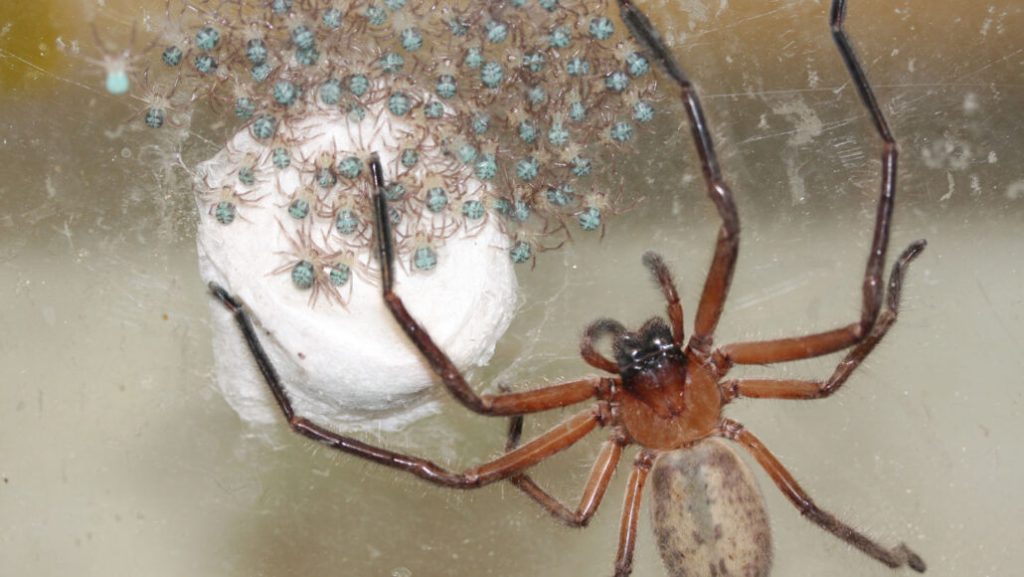These huntsman spiders do something weird: live together as a big, happy family

How descendants of cannibals evolved abilities to share a home mostly without killing each other — never mind the rare oopsie snack — resonates after several pandemic years.
Among the many kinds of velvety Delena huntsman spiders, four species from Australia show what for their kind is a downright freaky tolerance between a mom and her live-in offspring. “Cannibalism might happen occasionally, but with Delena cancerides, it’s almost never,” says behavioral ecologist Linda Rayor of Cornell University, who has studied them in the wild and in her lab for 20 years.
Not eating their own kind isn’t really the oddity here: Cannibalism varies a lot among spider species, Rayor says, but overall, it’s mostly a move of solitary kinds of spiders if they meet outside of flirting or baby-guarding demands (SN: 4/25/22).
A small number of Delena species, however, generally tolerate their own kind. The only exception Rayor sees in D. cancerides are a wild-caught female’s takedown of a full-grown male still in her cage after she lays eggs. “Wild-caught females are very intolerant of males who stick around too long,” she says.
What’s really strange, at least in the arachnid world, is these spiders’ shared family life. Out of the more than 50,000-plus known spider species, biologists classify fewer than 80 as truly social. In the most complex, hundreds or even thousands of females spin a great airy silken city, where some stay their entire lives. However, Rayor says, “my huntsman don’t do that.”
Some other biologists wouldn’t consider the Delena spiders Rayor studies as fully social — no spun-silk Sydney. Yet these spiders are not truly solitary either. A female doesn’t spin a web but shelters in a crevice, perhaps behind peeling bark on an acacia tree or under a slab of rock. These crevice-dwellers’ bodies look unusually flattened in profile: “a credit-card spider,” one scientist called the species, with some poetic license.
When a female triumphs in finding real estate, the kids can linger for months in her splendid mom cave — the kids with no sex life yet, that is. Never mind that older offspring already go out hunting on their own at night, or that often one or two later clutches of little ones hatch before the older ones leave. Spider moms guarding poppyseed-tiny hatchlings are common. Living with capable, nearly grown offspring, is strange in the arachnid world.
The most sociable of these sort-of tolerant moms, D. cancerides, lets a cohort of youngsters hang around the home for about a year after hatching. That’s a good portion of life for spiders that live only two and a half years. One of the reasons for doing so may sound familiar: Suitable housing can be hard to find.
Rayor once thought hanging with mom was an Australian thing, but she has now learned about tolerant moms from Madagascar in a Damastes species. To study the evolution of traits that add up to family life in the five species, Jacob Gorneau, now at the California Academy of Sciences in San Francisco, and his Cornell colleagues used four genes from spiders in 37 huntsman genera to create the most ambitious genealogical tree yet of the family. Then Rayor turned to her decades of data to see what behaviors appeared on branches leading to lingering kids.
For instance, a form of egg sac called “plastered” — not drunk but spun like a firmly anchored splat on a surface of spider retreats — shows up in branches with the family-tolerant behavior, the researchers report in the September issue of Molecular Phylogenetics and Evolution.
Spiders spin various shapes of outer sacs that discourage egg raiders. Spiders in a fixed retreat can conveniently anchor a sac, unlike some other moms that carry eggs with them. Also the more spread-out, plastered form might — Rayor emphasizes this is speculation — fit better in tight crevices than the puffier throw-pillow styles of egg sacs would.
Delena spiderlings still carry abundant egg yolk with them when they clamber out of the egg sac. They don’t eat until after their first molt. “They’ve got these big, fat, green abdomens,” Rayor says. “They don’t have long legs, so they waddle.”
Once they molt, one benefit of this family lifestyle could be table scraps for the littles. Very young spiderlings are “ridiculously small,” Rayor says, and can handle food only about the size of a fruit fly. The chance to sneak extra shreds of meat from an older sib could greatly boost nutrition. Older sibs probably would rather not share, but Rayor sees “tolerated theft.”
Cute babies may not matter to a spider mom, but maybe they should to humans. Gorneau, once “very afraid of spiders,” wants to fight the stereotype of spiders as aggressive dangers. Rayor’s spiders strike him as “stoic,” mostly sitting quietly. Rayor’s lab full of spiders in their homes, he now finds, is a “calming environment.”